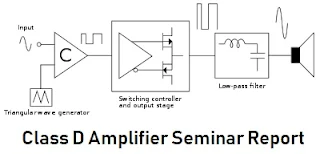Class D Amplifier Seminar Report Abstract
A Class D amplifier's high efficiency makes it ideal for portable and compact high-power applications. Traditional Class D amplifiers require an external lowpass filter to extract the audio signal from the pulse-width-modulated (PWM) output waveform. Many modern Class D amplifiers, however, utilize advanced modulation techniques that, in various applications, both eliminate the need for external filtering and reduce electromagnetic interference (EMI). Eliminating external filters not only reduces board-space requirements, but can also significantly reduce the cost of many portable/compact systems.
Class D Amplifier Introduction
A class-D amplifier is one in which the output transistors are operated as switches. When atransistor is off, the current through it is zero. When it is on, the voltage across it is small, ideally zero. In each case, the power dissipation is very low. This increases the efficiency, thus requiring less power from the power supply and smaller heat sinks for the amplifier. These are important advantages in portable battery-powered equipment. The “D” in class-D is sometimes said to stand for “digital.” This is not correct because the operation of the class-D amplifier is based on analog principles. There is no digital coding of the signal. While some class-D amps may indeed be controlled by digital circuits or include digital signal processing devices, the power stage deals with voltage and current as a function of non-quantized time.Before the advent of the class-D amplifier, the standard classes were class-A, class-AB, class-B, and class-C. The “D” is simply the next letter in the alphabet after “C.” Indeed, the earliest work on class-D amplifiers involved vacuum tubes and can be traced to the early 1950s.
Recent advancements in Class D modulation techniques have allowed Class D amplifiers to flourish in applications where linear amplifiers once dominated. Modern Class D amplifiers include all of the advantages of Class AB amplifiers (i.e., good linearity and minimal board-space requirements) with the added bonus of high power efficiency.
Currently, there are a wide variety of Class D amplifiers available, thus making them suitable for numerous applications. These applications range from low-power portable applications (e.g., cell phones, notebooks) in which battery life, board-space requirements, and EMI compliance are of utmost importance, to high-power applications (e.g., automotive sound systems or flat-panel displays) where minimizing heatsinking requirements and heat generation is vital. Having a fundamental understanding of Class D amplifiers and their recent technological advances will aid designers in selecting the correct amplifier for their application and allow them to successfully weigh the advantages and disadvantages of specific features.
We have provided the best links which will help to make Class D Amplifier Seminar Report. Download these pdf for seminar report on Class D Amplifier.
Incoming searches:
Class D Amplifier Seminar Report, class d amp seminar report, download seminar report for class d, class d amplifier project report download, class audio amplifier seminar report


0 comments